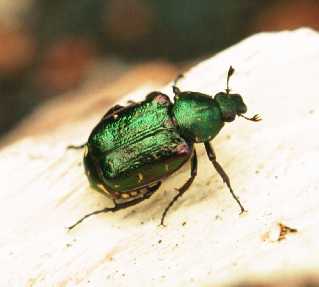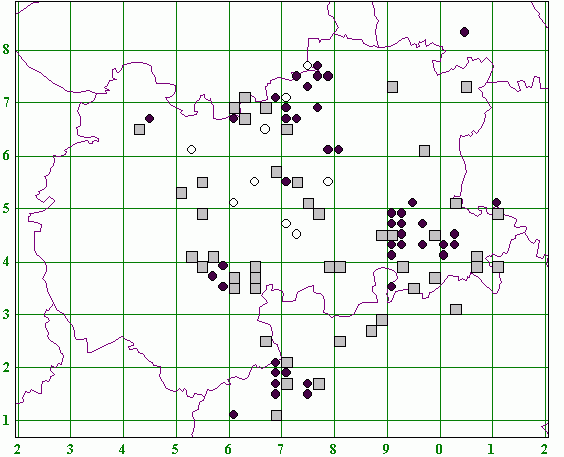
Worcestershire Record No. 17 November 2004 p.16
Harry Green
|
|
| Noble chafer Gnorimus nobilis photo Matt Smith |
To place this note in context readers may wish to read the article in April 2004 Worcestershire Record (no 16 pages 10-11) and in previous issues, or view all the notes we have published on the web site www.wbrc.org.uk.
This striking and rare beetle is the subject of a UK Biodiversity Action Plan and the lead partner in work on the species and its conservation is the People’s Trust for Endangered Species (PTES). Locally, we have been working closely with PTES and Steve Bloomfield (Worcestershire Wildlife Trust Sites and Species Officer) and I are privileged to sit on the national BAP Focus Group.
Studies in Worcestershire, Herefordshire and Gloucestershire have included a series of specialist surveys by leading entomologists (primarily Paul Whitehead, Keith Alexander and Matt Smith) focussed on specific areas; collation of all records past and present; public appeals for possible sightings and follow-up on these; and searches by local entomologists at likely sites.
New sites have been found in all three counties during 2004.
Matt Smith has collated all records and I am grateful to him for allowing publication of the map (Figure 2). This summarises all the distributional information available to date, based on tetrads. Apart from other Gloucestershire sites to the south, there are very few national records elsewhere in Britain since 1998. On modern evidence Worcestershire, Herefordshire and Gloucestershire contain most of the noble chafers present in Britain at the present time. These counties are of course famous for their orchards and fruit cultivation and old orchards .
As described in the April 2004 article noble chafers are closely associated with decaying fruit trees in old orchards . The larvae feed within the red-rot within these trees. They leave behind very characteristic pellets (frass) which is a good indication of their presence. Fragments of beetle can also be found. Many records are based on this evidence. The fruit trees most frequently used are plum, apple and cherry.
The great conservation concern for the welfare of the noble chafer is the continuing loss of old orchards. Most of the once-extensive plum orchards of the Vale of Evesham have been removed as have the cherry orchards of west Worcestershire. Many semi-derelict apple orchards remain, often because they are pleasant features near to farm houses and buildings, and also providing occasional shelter for grazing farm animals.
 |
Present known distributional information on Noble Chafer in
Herefordshire, Worcestershire and the north part of Gloucestershire. Map prepared by Matt Smith. |
During 2004 evidence of noble chafers were found in several new sites, notably near Naunton Beauchamp (north of Pershore) and on the western edge of Worcestershire at Knghton-on-Teme. In both cases only one apple tree in each large old orchard contained frass and beetle parts, although surveyors cannot always gain access to the centre of decaying trees, even with a long-handled spoon! Owners of another remnant orchard near Rochford, Tenbury Wells, are also convinced noble chafers have visited their conservatory but to date we have been unable to confirm this record. We are very grateful to the owners of these sites for contacting us following publicity in Worcestershire Wildlife News and on local radio. Further survey work in west Worcestershire is continuing.
Kevin McGee provided several sightings this year – see his article on his recent records in this Worcestershire Record. His observation of three beetles emerging from an old cherry tree and flying away is probably unique in Britain, and Kevin has probably seen more live beetles than anyone else in the country (at Tiddesley Wood, near Drakes Broughton and at Wyre Forest). Most of us hunters have to be satisfied with frass and bits of beetles!
Wyre Forest and country to its south appears to be key areas for the species. Interestingly, this summer, I was able to re-find trees with evidence first discovered by Matt Smith in 2003. Sadly, in one of these orchards many of the old trees have since been removed, despite Rosemary Winnall’s advice to the owners. This highlights the threat to the chafer. Old orchards may be subject to tidying-up. Ideally new fruit trees should be planted amongst the old and the latter left to decay naturally. These old trees are often host to rich invertebrate faunas.
Please keep a lookout for Noble chafer. I should be pleased to hear of any orchards worth visiting or of possible sightings. Incidentally, we usually warn people to beware the somewhat similar rose chafer but in recent years we have received no records of this species.
| WBRC Home | Worcs Record Listing by Issue | Worcs Record Listing by Subject |